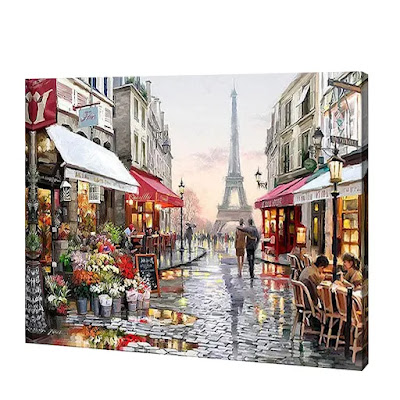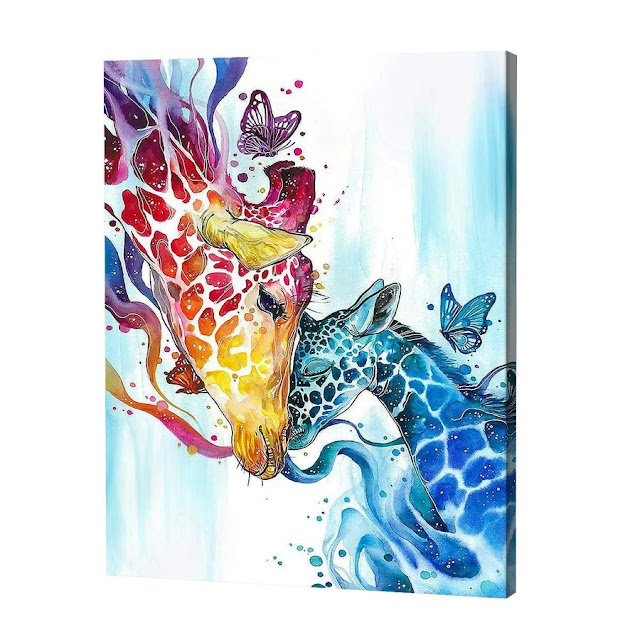Why Paint by Numbers Kits are Popular Among Art Students?
Acclaimed as bold experimenters, art students are often presented as creating an endless number of canvases with the crazy application of paint. While that idea is true in many ways, the story for many students learning the art of creating is much broader. In structure, creating art is more than just having talent; it's also governed by technique, patience, and process. Enter the new tool for aspiring artists: Paint by Numbers Kits, which found a place in the toolkit of many young artists who had no established process or routine for creating art.
Paint by Numbers has transitioned from a children's or beginner's craft into a legitimate resource that various art students will now use at all levels. These kits have been utilised by high school art students and in university studio spaces, not as a source of relaxation or entertainment, but to develop skills and find inspiration. But what will make Paint by Numbers Kits so attractive to young artists in formal education situations?
Let's explore these motivations for why Paint by Numbers Kits are on the rise for the experience of the art student, not to be seen solely as numbered lines to follow.
1. A Gentle Introduction to Painting Techniques
For new painters, this can seem daunting... Composition, measuring, brush techniques, color mixing and learning proportions - all of this is overwhelming. Paint by Numbers offer an environment to begin painting with less pressure and to paint step by step and to become comfortable handling brushes, the behavior of paint and understanding how the sections of painting combine to create an image.
Art students who are starting to learn how to work with acrylics find these kits are especially beneficial. They learn how thick or thin to apply the paint, how to work to stay within lines, and how different colors and shades combine to create depth and lighting. Students will develop foundational knowledge of paint handling and manipulational skills which will easily transfer to more advanced freehand works later.
2. Structured Practice for Skill Reinforcement
Repetitive practice is very important in traditional art education. Repetition does not always mean free-hand sketching or copying something from a still life; Paint by Numbers can represent a structured repetitive practice. It still allows for the application of skills in a structured, repetitive manner. Every separate canvas develops hand coordination, spatial recognition, and detail management, but this is not guessing what to do for the next movement - there is deliberate practice in finishing each section.
Repetitive practice in a deliberate way can also help students who struggle with perfectionism. Many young artists tend to abandon projects half-complete when they feel the work does not live up to their expectations. Because Paint by Numbers provides a definite path from start to finish, it creates motivation to remain engaged and develops confidence in the act of completing the project.
3. A Visual Lesson in Colour Theory
Colour theory underpins art education. Artists need to recognise how colours interact, contrast, and harmonise in a painting to elevate it from mundane to awe-inspiring through paint colour choices. Paint by Numbers can provide art students with an experience to help them understand those relationships.
When students follow a key, they see the palette they selected and how the colours complement or contrast with each other in their Paint by Numbers. Additionally, students can see how the artist interacts with the different warm and cool colours to create depth and emotion. After the students complete these Paint by Numbers, it is reasonable that students will remember this associative experience when they make colour selections and palettes in their future personal work.
In a more advanced context, these students may replace the colour options with alternative colour options from a kit, which can help develop students' understanding of the variations of tones to better compose their artwork.
4. Mindful Creativity to Reduce Academic Pressure
Being an art student is not just about painting; frequently, art students have to complete theory exams, critiques, deadlines, and there's competition. Given that each of those factors can exert pressure and stress in its own way, the pressure to continually create and produce new things can build up and become considerable. This is why many art students find their bricolage (take what works and use it to build) and settle on paint by numbers as a creative way to relax, but express to maintain a semblance of creativity.
This is the time to switch off the inner critic and merely enjoy the creations. Concepts and designs have all been planned out for the student, as they just follow the numbers. This stress free practice allow for a mental reset and has the potential to add productivity to the overall work load by helping to the students function better and reduce burn out like symptoms.
And let's not forget the average art student who juggles school and part-time jobs or other forms of time consuption; having access to an mindless, creativity outlet with little to no energy or planning is huge.
5. Development of Patience and Artistic Discipline
Painting involves not only creativity but also the instilling of discipline. Long hours, tedious details, and slow invention are part of the creative process. Paint by Numbers inherently teaches students the discipline needed throughout the creative process.
Each canvas requires time and and conscientious effort. Students learn how to step back and look at small sections of the canvas, follow instructions explicitly, and follow through with consistent technique. All of these habits provide them with support as they undertake additional creative work such as mural painting, digital painting and even sculpture.
As students develop patience, they also learn the strength it takes to overcome issues and complete larger works without struggle. It also pays off through the understanding that every large work is built on the back of small steps, specifically, a Paint by Numbers project, as these very steps are a gradual evolution of the piece.
6. A Fresh Perspective on Composition and Framing
A surprisingly rich benefit of Paint by Numbers is the exposure to different formats of composition that each kit (landscape, portrait, abstract) will demonstrate. It starts each student thinking about relatively consistent formal options, and as they complete more kits, they may begin to recognise how balance, focus points, and perspectives are established in a professional composition.
For example, when a student completes a kit of a coastal sunset, they aren't just learning about blending warm chaotic tones; they are also learning about horizon lines, depth of field, and where to place the subject. This provides a useful reference point for the potential original artwork they can create from scratch.
7. Bridging Generational Creativity
Most young artists have a kit of some form that includes paint-by-number kits. These kits can create generational connections, where students remember painting sessions with Kids Paint by Numbers by reflecting on their childhood. There is something about revisiting that activity in a more sophisticated version and recapturing that same form of creativity.
Some art educators have students complete paint by numbers projects to show growth. For example, after completing a more child-friendly version of the project throughout their learning, students will paint the more complex and intricate kit and compare their brush stroke use, degree of tone and colour layering over time. By comparing paint by numbers projects, students learn to reflect on their growth and become aware of their strengths and areas of improvement.
8. Creativity Without Pressure in Group Settings
Art students tend to work together or in workshop contexts where collaboration with peer input is shared. In these contexts, Paint by Numbers can be a good warm up or end-of-day activity because it encourages social engagement and plant the seed of collaborative creativity while allowing students to engage in peer discourse and relationship building without competition, like working in a group and sharing critiques or being graded on their projects.
Additionally, Paint by Numbers is a great exercise for art clubs or adjunct programs because it includes students with varying levels of skill, while also providing a shared experience and sense of inclusion and confidence across the group.
Final Thoughts
Paint by Numbers Kits do more than just provide an alternate form of painting—they provide a systematic, but still creative, experience that aligns with the path of an art student. There are many actual elements of benefits to both their academic learning and personal development, in helping them learn brush control and colour theory, discipline and stress relief.
They do not stand in place of traditional methods or freehand discovery. They are great complements to an art student journey. For many students, they will be the start of a more in-depth understanding of technical artistic practice—and a lifetime enjoyment of painting.
To the art student, the Paint by Numbers canvas is not a project. It is practice, therapy, and inspiration rolled into one.



Comments
Post a Comment